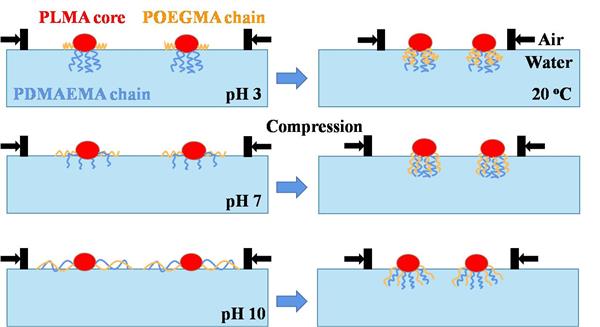27.【J. Polym. Res.】Interfacial Aggregation Behavior of Triblock Terpolymers.
作者:Guanying He, Gangyao Wen,* Athanasios Skandalis, Stergios Pispas, Dongxue Liu, and Wang Zhang
关键字:LB film, block copolymer, terpolymer, Langmuir monolayer
论文来源:期刊
具体来源:Journal of Polymer Research 2022, 29: 383.
发表时间:2022年
The aggregation behavior of amphiphilic diblock copolymers at the air/water interface has been studied extensively, whereas that of triblock copolymers was less studied due to the complexity. In this work, the aggregation behavior of two amphiphilic triblock terpolymers of poly[2-(dimethylamino)ethyl methacrylate]-block-poly(lauryl methacrylate)-block-poly[oligo(ethylene glycol) methacrylate] (PDMAEMA-b-PLMA-b-POEGMA) with different molecular weights and compositions was studied at the air/water interface by the Langmuir film balance technique and atomic force microscopy. With the increase of subphase pH value, the extension degrees of PDMAEMA and POEGMA blocks/segments on the water surface gradually increase, and the surface pressure versus molecular area isotherms move to large molecular areas. Under different pH conditions, the contribution of POEGMA blocks on the isotherms is predominant, while PDMAEMA blocks provide steric hindrance for the former. That is, the length of POEGMA blocks adsorbed on the water surface under acidic/neutral conditions is larger than that of PDMAEMA segments because the latter are completely/partially protonated and dissolve in water, respectively. They are unprotonated under alkaline conditions, but their extension degree at the interface is also smaller than that of POEGMA blocks. Upon temperature increase, the limiting areas of the isotherms first increase and then decrease due to the increased intermolecular repulsions of the hydrophilic PDMAEMA blocks and the collapse of POEGMA blocks, respectively. The Langmuir?Blodgett (LB) films of PDMAEMA-b-PLMA-b-POEGMA present isolated circular micelles composed of PLMA cores and PDMAEMA/POEGMA mixed coronas because the long hydrophilic coronas hinder the contact of the former.

Article address: https://doi.org/10.1007/s10965-022-03244-7
Full-text access to a view-only version: https://rdcu.be/cTCz4.